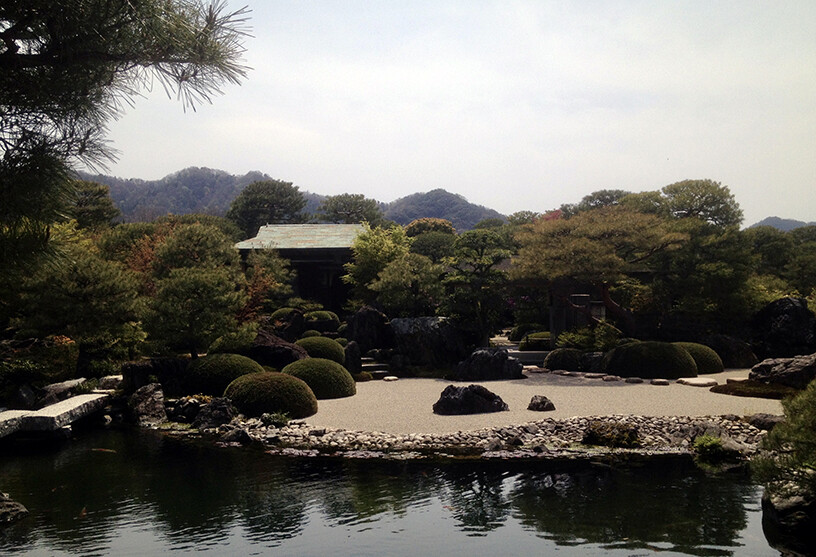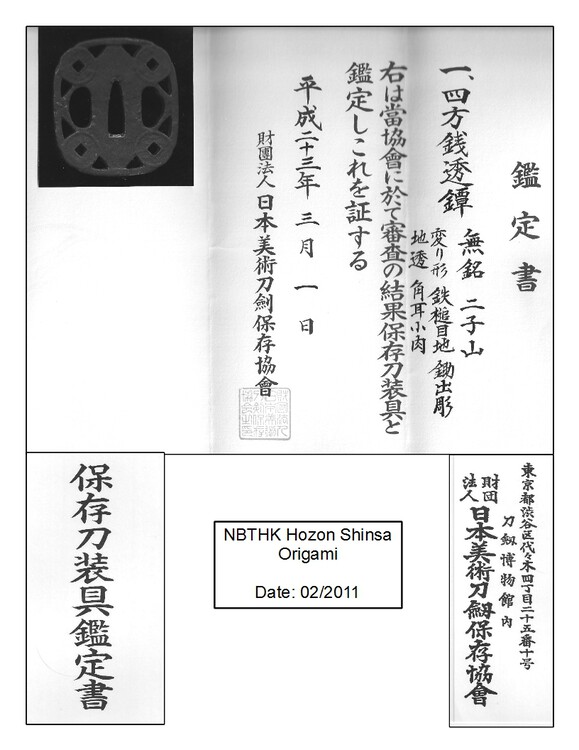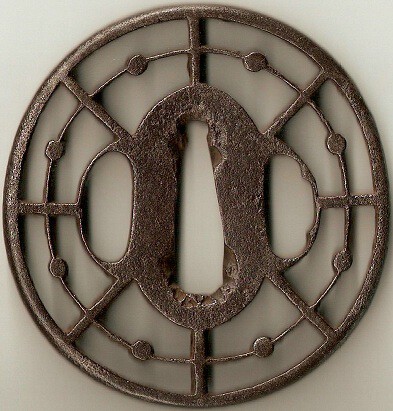-
Posts
2,875 -
Joined
-
Last visited
-
Days Won
3
Everything posted by Soshin
-
Hi Pete, Good to hear from you. I think the green sheets for shinsa fail is a good idea. Let me write a letter to the sword museum in Tokyo. Yours truly, David Stiles
-
Hi Ford, I have done this and have came to the conclusion that if I for example had Mr. Haynes cast tsuba discussed by me above and have submitted it to NBTHK shinsa it would not be issued a shinsa origami and I would likely be told that the tsuba is "worthy of recycling" . This is a attempt at humor as the Japanese word hozon often gets translated as "worthy of preservation" and the Japanese do like to recycle. :lol: The point if it isn't clear is that when reputation is take out of the equation the tsuba would be judged as a modern post Edo Period reproduction of fairly good quality. This in turn would cause it to fail the shinsa test. Yours truly, David Stiles
-
I was reading through Sasano Sensei's second book (silver dust jacket) and it states that the Kanayama school of Owari Province made tsuba from the early Muromachi Period (Oei era) up until the banning of wearing of the dai-sho in public by Samurai (haitto-rei) during the early Meiji Period (1876). In Sasano's book like others sources I only have photo examples that date from the early Muromachi Period up until the early Edo Period. I was wondering if anyone on the Nihonto Message Board can provide me with reference, links, or photos of Kanayama tsuba from the middle Edo Period on up until the end of the Edo Period and first part the Meiji Period? This is for my own personal research and study. Thanks for taking the time to help me. Yours truly, David Stiles
-
I would agree with Steve's points. Japan's climate isn't at all friendly to anything of iron more or less a cast tsuba and if the skill and craftsmanship and artsitic value weren't there in the first place the tsuba wouldn't be taken care of and would quickly be heavily damaged or destroyed if not originally destroyed by use. I think the weapons include poorly made swords of the ashigaryu and ji-samurai of the Sengoku Jidai are no longer with us and are lost to history. Still extant historical records indicate these swords and by extension the tsuba as well as other weapons were very poorly made and show very little if any artistic value. Just think all those swords in movie Seven Samurai hoarded by the farmers and used by the Samurai and farmers trying to save the village. The movie is set in the Sengoku Jidai if I remember correctly. Yours truly, David Stiles
-
Nice story Ford and good food for thought. Thanks for sharing your experience. :D Yours truly, David Stiles
-
Hi Ford, Thanks for the information about Yamagane and I was thinking it was similar to Bronze but I will defer to your technical and "hands on" knowledge. Here is a direct link to the tsuba itself on the web with detail photos: http://www.nihonart.de/scripts/loupe/en_detail.php?id=171&titel=167a. Here is a scan of the text. I am not a advocate for thinking that cast iron was used in pre-modern Japan for tsuba but just wanted to provide some information that I came across in my study. Here is a back and white scan of the text discussing the tsuba. Yours truly, David Stiles
-
I would go with a tachi style tsuba from the late Edo Period. I had one for sale but it went very quickly in the sales section of the message board. On a related note. One shouldn't disregard eBay automatically. My current tsuba just issued NBTHK Hozon Shinsa Origami was purchased originally by me on eBay for about $95 USD. The deals might be rare but they are there and do happen once in awhile but if you are not very experience I don't recommend you buy anything off of eBay. Go with a well know dealer in Japan or someone on the Nihonto message board. Yours truly, David Stiles
-
Hi Ford, I am of the opinion that the vast majority Edo Period and earlier casting was done for soft mental (kinko) tsuba such as the kagamishi school which often used Bronze and Yamagane. In additon to the strength question wasn't it also not possible to generate the necessary heat in a cost effective manor using massive amounts of charcoal to make many cast iron tsuba? In Robert E. Haynes new book Study Collection of Japanese Sword Fittings. He sites a rare example of a cast iron tsuba on page 167 made during the late Edo Period by a tetsubin-shi a caster of iron tea kettles from an original tsuba by Munetoshi of the Myochin school. I think this tsuba is a very rare example and not at all representative. The vast majority of cast iron tsuba are from the Tasho Period and later and had no functional use. Yours truly, David Stiles
-
Hi Everyone, Here is more of the translation I did. The Futogoyama school based in Ono of Owari Province was a major center for Yagyu and Yagyu style tsuba production for the third and final period of Yagyu tsuba production during the late Edo Period. The school was headed by two generations of Norisuke (則亮) from around 1797 until about 1883. The date of 1883 I am using as it was the year of death for the second generation Norisuke. Additional informaiton can be found at the following website: http://kodogunosekai.com/2009/07/04/amida-yasuri-no-zu-%E9%98%BF%E5%BC%A5%E9%99%80%E9%91%A2%E5%9B%B3/. Feel free to comment and discuss. If anyone has an questions please let me know. Yours truly, David Stiles
-
Thanks Henry, I found all of the website and Kanji characters very helpful and I was able to translate the remaining sections. I will post what I found out this evening when I get back from work. Yours truly, David S.
-
Hi Henry and Christian, Here is what I have of the translation/transliteration so far. I find it interesting that for a mu mei tsuba the attribution isn't in brackets like I have seen on other papers. The Kanji without writting by it I have not been able to translate so far. Yours truly, David Stiles
-
Hi Everyone, Here is a collection of scans of the NBTHK hozon shinsa origami I pick up at the post office today. The attribution for the mu mei tsuba is to Futagoyama (二子山). Futagoyamam is a location in Owari Province. During the late Edo Period the school was well known for making high quality Yagyu and Yagyu like copies. Not sure what the remainder of the origami says about the motif but at some point I will take the time to translate it. If anyone can offer a quick translation to quicken my research I would greatly appreciate it. Thanks again for taking to view my first tosogu shinsa origami thread. Yours truly, David Stiles
-
Hi NMB Members and Guests, My first papered tosogu by the NBTHK is currently waiting at the post office as today is a holiday in the USA. I think this is sigificate as I have been a member of the NBTHK since 2007. It is a tsuba posted originally on the message board on a discussion of Edo Period coins and their use as motifs on tsuba awhile ago. Once I get it tomorrow I will post photos of the hozon tosogu shinsa origami. As a starter I will post photos of the tsuba I did before sending it off for shinsa back in December 2010. Enjoy and all comments and questions are welcome and thanks for looking. Yours truly, David S.
-
Hi Ron, Two famous artists working on and involved with a work can some times happen. Here is any example of a Umetada sukashi tsuba I have with two mei posted on the translation message board as I need help with the mei: http://www.militaria.co.za/nmb/viewtopic.php?f=15&t=10487. Both were head masters of the mainline Umetada based in Kyoto. The funny thing about Shigenaga is that he was the head master of school for a period of time when Umetada Myoju his older brother had transfer control of the day to day operations of school to him and was working independently. Yours truly, David S.
-
Hi Henry, I should have better qualified and develop the statement and not just make a drastic generalization in my original post. Yours truly, David S.
-
Hi Henry, I was referring to low relief carving specifically seen on the tsuba discussed in the tread and was not really thinking of sukashi (i.e. positive openwork) you would see in the Owari Sukashi and Akasaka schools. Some of the carving skill of the early generations of Kinai school of Echizen have wonderful detail and skill on iron that is compared to Owari Sukashi and Akasaka school relatively homogeneous in character. Here is a good Ko-Kinai Example I like: http://www.users.on.net/~coxm/kinai%20dragon%20gold%20ana.jpg Yours truly, David S.
-
Hi Peter, The attack from the typo from hell. This drinking and the Nihonto message board don't mix well. On a positive note we are talking about Tosogu and no deadly antique weapons are involved. Yours truly, David S.
-
I don't think you can get that level of quality craving with such a heterogeneous iron displaying much activity. As to the other points I think Henry is correct. The craving quality is good but the rim is poorly done and well as the shape of the seppa-dai. Both of these things I feel you often seen in late Edo pieces. I do need to restate my opinion and that is overall the tsuba is good due the quality of the cravings but in some respects the tsuba is a "mixed bag" and the quality not consistent. Another possibly is that the tsuba was not made by a professional tsubako but someone who could just do very detail cravings. This would explain the inconsistency in the quality of the tsuba. Just my two cents again. Yours truly, David S.
-
Hi Florian, The detail and deepness of the carving of the dragon is dynamic and intricate the first thing that points to the above average quality. This was noted above by others as well on the message board. The carving of the water waves is also good enough to produce the effect of obscuring parts of the dragon's body indicating that has just about to emerged from the "monster" wave to wreak havoc. Generally speaking there is master work from all time periods but the overall quality of pieces from the late Edo Period is fairly poor compared to earlier times in the Edo Period. You can get an idea of this by looking at many tsuba and start understand the characteristics that aid in determining their age. Having books are also helpful. A more detail discussion is best left to another thread as it is a complex topic. Here is an example of a late Edo period masterpiece produced right at the end of the Edo Period (circa 1855): http://kodogunosekai.com/. Yours truly, David S. Edit: Fix a funny typo between the words carving and craving.
-
Hi Florian, If a student collaborated in making the tsuba often it would bare two mei on the seppa-dai. I have one tsuba like this in my collection and have seen a few others like this as well. I agree the rim does look a bit unfinished or it could of had a fukurin or soft metal cover (like shakudo or copper) that was lost at some point. Overall I still think it is a nice tsuba and above average for the time period it was made. Yours truly, David S.
-
Dear Florian, Nice tsuba the low relief craving is really good. The dragon looks evil and angry possibly coming out of a tsunami wave. Could you show a photo of the tsuba rim? The style reminds me of some of the better work during the late Edo Period and thickness of the plate also points to that time period as well. Thanks for posting the tsuba for discussion. Yours truly, David S.
-
Sorry Jason G., I should have been clearer in my statement. I was only referring to the tsuba you started the tread with and wanted to identify. Yours truly, David S.
-
Jason G., I think Grey's and Lorenzo's and everyone else comments about the tsuba in question are correct. Your tsuba is a modern cast copy. Due to the low quality I would say likely it was made in China or Taiwan. Here is a tsuba from my collection of a similar sukashi (open work) design. Notice the differences discussed by Grey. I think my tsuba is a Shoami tsuba and dates to the late Edo Period. I hope you find the information helpful. Yours truly, David S.
-
I would agree with Ford about the attribution to the Kyoto based mainline Umetada school. The overall shape and rim I think indicates Umetada school as well as the use of gold inlays. The middle Edo Period also sounds reasonable as to the tsuba age. Yours truly, David S.
-
I would agree with Ed those type of inscriptions about what iron was used to make the tsuba are rare but are existent. In the recent Robert E. Haynes book focused on his study collection he provides an example if I remember correctly of such a tsuba. Now if the inscription are really truthful is another story. Yours truly, David Stiles








